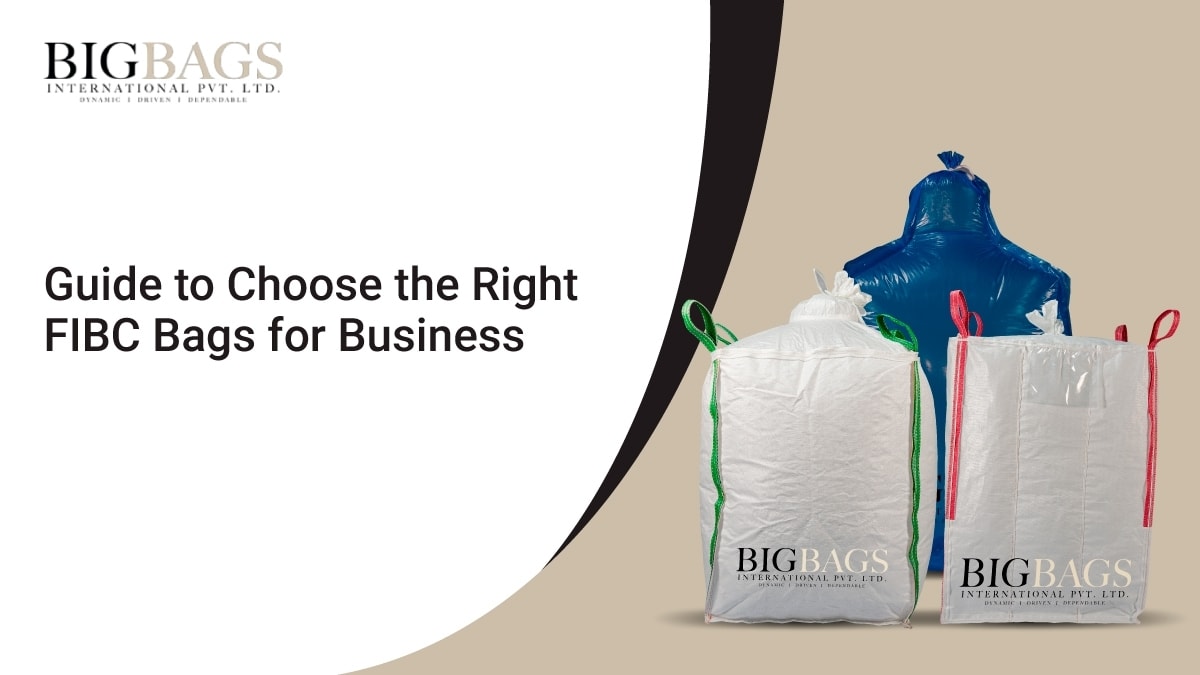With a plethora of FIBC bags manufacturers and varieties, selecting the right FIBC bag vendor for your business can be overwhelming.
Choosing the right type of bag is pivotal to ensuring safe packaging, convenient transportation, and easy handling of the product.
So, to help you make the right choice with FIBC bags for your business, we’ve put together a guide.
Let’s get started
Why Choose FIBC Bags?
FIBC (flexible intermediate bulk container) bags are made from thick woven strands of oriented polypropylene, making them durable, flexible, and strong.
FIBC bags are the most preferred way of bulk packaging, storing, and transporting solid, dry, flowable material (grains, fertilizers, sand, etc.), and they’re especially used in industries like agriculture, chemical manufacturing, construction, and food production.
Also known as bulk bags, super sacks, and jumbo bags, these containers are reusable, lightweight, cost-efficient, and convenient for shipping.
How To Choose the Right FIBC Bags for Your Business
There’s no ‘one size fits all’ approach when choosing the right FIBC bags, as each type is suitable for specific products or industries.
When choosing the right FIBC bag for your business, the first step is to analyze the type of product you’re packaging, its storage, and transport methods. Based on this, you can identify the correct fabric type, bag size, coating, and filling methods and customize it with your packaging solution provider before going ahead with your jumbo bags order.
There are multiple extra accessories you can include with your bulk bag selections, such as color-coded lift loops, document pouches, logo printing, locks, etc., to make them unique.
The following crucial criteria are deciding factors in choosing the right FIBC bags.
1. Type of FIBC Bags
FIBC bags are designed using different types of materials. The standard categorizing system for FIBCs uses letters A, B, C, and D, each of which offers varying degrees of electrostatic protection and indicates the bags’ physical properties.
Depending on whether the product is hazardous or not, these properties are critical to determine employees’ safety against electric shocks and to minimize risks of fire and explosion.
- Type A: These are standard bulk bags made of woven polypropylene. They are sturdy but have no static protection; hence, they’re strictly used only to transport non-flammable products.
- Type B: They’re made with polypropylene woven material as Type A but come with an additional low breakdown voltage material to dissipate brush discharges and sparks.
- Type C: These conductive FIBCs are made from polypropylene fabrics interwoven with conducting threads designed to control electrostatic charges by grounding them.
- Type D: These are made from woven static and anti-static dissipative fabrics that allow electrostatic charge to scatter in the atmosphere without being grounded, hence preventing sparks or brush discharges.
2. Size Considerations
Apart from the length and width of the FIBC bag, it’s important to consider the products’ dimensions, weight, and handling methods.
Right-sizing your jumbo bag helps in minimizing wastage and avoids any untoward injuries that would otherwise occur with an improper-sized bag.
To determine the exact size of the FIBC bag, you should consider two crucial criteria: the density of product per cubic foot and the dimensions of pallets used. These two criteria help your FIBC bags manufacturer figure out the dimensions for your required capacity and design bags that fit perfectly on your pallets.
3. Construction Styles
FIBC bag manufacturers use various construction styles as they can affect the application of the bag. The jumbo bags’ construction can vary in their:
- Shapes
- Top and bottom styles
- Loop configuration
The three common construction types of FIBC bags in the industry are:
- Circular: This style of bag won’t maintain its shape, and it bulges when loaded because it’s made on the loom as a tube.
- U-Panel: This bag has two pieces of fabric resembling a U shape sewn together to maintain the square shape of the bag better than the circular style.
- Four-Panel: The four-panel bag is the best bag for staying square (besides a baffle bag). It’s made up of four pieces of fabric for the sides and one for the bottom, sewn together to hold it in a cube shape.
4. Filling and Discharging Bulk Bags
The loading and discharge of goods determine the construction of the filling inlet and discharge outlet of the FIBC bags.
Options such as duffle tops, spout tops, full open tops, and baffle bags can be used for easy loading, while bottoms can be designed either flat or with a discharge spout. The loop styles can be customized to standard or cross-cornered — one loop, two lift loops, or four lift loops — based on loading equipment.
5. Inner Lining and Coating
Generally, FIBCs are made from woven polypropylene which makes it natural for these bags to have small gaps that allow air and moisture to seep in and fine granules and powders to pass through.
Hence the product going into the jumbo bags determines whether the fabric needs any coating or lining.
Only an expert FIBC bag manufacturer can help you decide which material works best for your business to keep your product fresh for the end consumer.
Why Choose Big Bags International for Your FIBC Bags Needs
Considering all of the above factors should give you a good idea of what type of FIBC bags will best suit your business needs.
Big Bags International is capable of fulfilling all your custom requirements while promising you quality and prompt delivery. Being a professional FIBC bags manufacturer and supplier, we will help you make the best choice for your business. Check out our website and learn more today.

